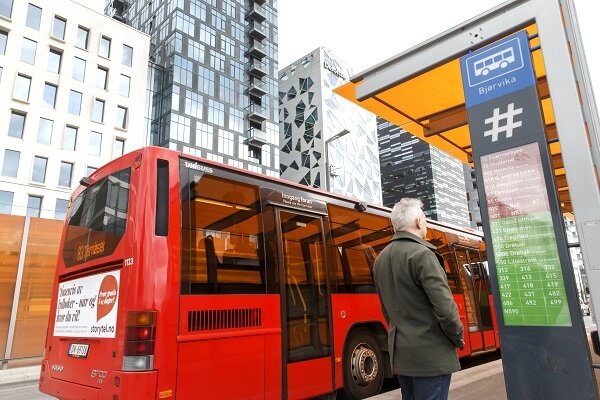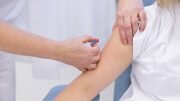Ruter will control how many passengers can board their means of transport in Oslo. Seats will be marked that passengers can sit on.
These are some of the measures Ruter are introducing to ensure recommended infection control and help passengers keep a metre away on board. The measures mean that the capacity of buses, trams, subways and boats are greatly reduced.
The CEO of Ruter, Bernt Reitan Jenssen, reminds that the government’s call to avoid travelling collectively if one does not have to, still applies.
“Pupils and people with critical and important social functions are now the priority to travel to and from work and school,” says Jenssen.
Since Monday, Ruter has been running according to the regular timetable to increase the total capacity with the current infection control measures.
© NTB Scanpix / #Norway Today





This will NOT help.
Buses and train cars are closed atmospheres, and the South China Morning Post article describes how people on a bus became infected-positive MUCH farther away than the guideline.
“Coronavirus can travel twice as far as official ‘safe distance’ and stay in air for 30 minutes, Chinese study finds” [Actually, it is now found it can stay in the air up to 3 hours.]
“Authorities advise people to stay 1-2 metres apart, but researchers found that a bus passenger infected fellow travellers sitting 4.5 metres away
The scientists behind the research said their investigation also highlighted the importance of WEARING FACE MASKS because of the length of time it can linger”
So WHY is Norway stubbornly CLINGING to opposing *everyone* wearing even homemade facemasks, when more and more countries are making wearing them in public mandatory?? Germany, France, Israel, Austria, Czechia, etc., and the U.S. Center for Disease Control is strongly recommending – since it cannot “order” this – wearing them to our states and cities.
Many London bus drivers have already died from coronavirus, and Mayor Khan has appealed to Britain’s Tory/Conservative government to make facemasking mandatory for passengers as well as drivers … but Johnson’s government ignores him.
Have the Ruter administrators appealed to Norway’s Solberg/Høyre/Conservative government to do so? (I don’t have or want a car. My bus drivers are my friends.)
On our carrier Theodore Roosevelt there was a major coronavirus outbreak, and our SecDef Mark Esper ordered all servicepeople to make their own facemasks out of t-shirts. (And since, the Army has made its own study of the best materials and found something interesting: Military com, “Army Says It Has Found the Best Fabric for DIY [Do It Yourself] Face Masks”
Norway had an outbreak on one of its ships. Has Forsvars/Defence “quietly” ordered facemasking for Norway’s servicepeople? And if so, why shouldn’t everyone in Norway be facemasking?
Meanwhile, according to an article in today’s British Independent, the air industry is taking the initiative to demand and take preventive protective measures, wanting all passengers to be wearing facemasks. However, the airlines and/or airport authorities should be providing cheap, inexpensive masks at the airport – not demanding passengers already have their own.
And even homemade facemasks *can* significantly reduce “viral load” in the air, according to this Cambridge Univ. 2013 report by Davies and Giri:
OBJECTIVE: This study examined homemade masks as an alternative to commercial face masks.
METHODS: Several household materials were evaluated for the capacity to block bacterial and viral aerosols. Twenty-one healthy volunteers made their own face masks from cotton t-shirts; the masks were then tested for fit. The number of microorganisms isolated from coughs of healthy volunteers wearing their homemade mask, a surgical mask, or no mask was compared using several air-sampling techniques.
RESULTS: The median-fit factor of the homemade masks was one-half that of the surgical masks. Both masks significantly reduced the number of microorganisms expelled by volunteers, although the surgical mask was 3 times more effective in blocking transmission than the homemade mask.
CONCLUSION: Our findings suggest that a homemade mask should only be considered as a last resort to prevent droplet transmission from infected individuals, but it would be better than no protection.
https://www.ncbi.nlm.nih.gov/pubmed/24229526
Weeks ago, now, China’s chief epidemiologist criticized Western countries for not making everyone facemask mandatory, and France, Germany, Israel, Austria, Czechia, and others are.
Our own CDC now finally recommends them, and SecDef Mark Esper has our servicepeople making them out of t-shirts!, until better ones can be had.